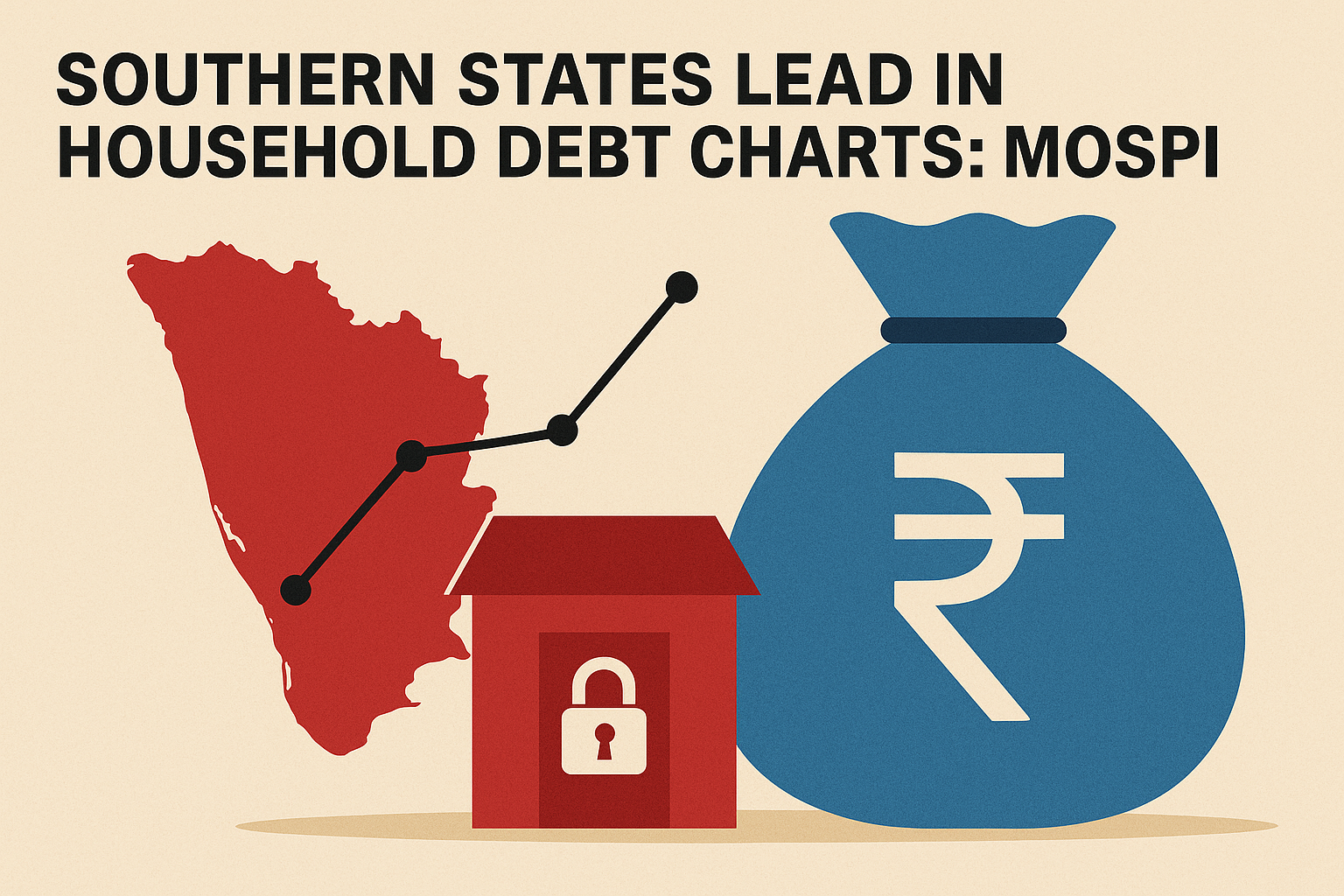Southern states lead in household debt charts: Mospi
Business Standard

Key arguments
- Higher indebtedness in southern states ≠ distress: It primarily reflects greater prosperity, enabling households to access and service larger loans.
- Credit penetration and disposable incomes matter: Southern households have higher per-capita incomes, higher credit-to-deposit ratios, and more assets, making lenders confident to extend loans.
- Debt purpose matters: Loans in prosperous states often finance productive assets (housing, education, small enterprise), unlike distress borrowing which signals vulnerability.
- National context: At the national level the share of adults with outstanding debt was about 15% in 2021 — the state variation is large and driven by local economic structure and financial intermediation.
- No rural/urban significance: The study reportedly found no strong rural–urban split in indebtedness shares.
3. Author’s stance and tone
- Analytical and explanatory. The article leans toward the view that high indebtedness in the South is not alarmist — rather it reflects credit market depth and capacity to service debt.
- Cautious optimism: It signals both opportunity (credit enabling growth) and the need to understand why loans are taken (consumption vs productive investment).
4. Implicit assumptions & possible biases
Assumptions
- High indebtedness in prosperous states mainly finances productive investment rather than consumption or distress coping.
- Credit markets in the South are well-regulated and households are not overleveraged.
Potential biases
- Positivity bias toward credit: The article emphasizes the benign view of debt (credit as facilitator) and underplays scenarios where high indebtedness may still create household fragility (e.g., job loss, interest shocks).
- Insufficient granularity: It relies on state averages and assumes homogeneity within states — masking intra-state and caste/class differentials.
5. Pros and cons of the article’s argument
Pros
- Uses official MoSPI/NSO data — credible empirical basis.
- Highlights the nuanced distinction between high indebtedness and overindebtedness/distress.
- Points policymakers to investigate loan purpose and servicing capacity rather than raw debt numbers.
Cons
- Lacks deeper analysis of loan composition (formal vs informal, secured vs unsecured, tenor, interest rates).
- Little attention to vulnerable subgroups (women borrowers, agricultural households, MSMEs) who may face disproportionate risk.
- Does not examine systemic risks from NBFC exposure, seasonal shocks, or macro stress scenarios.
6. Policy implications & recommendations (actionable)
A. Improve data & diagnostics
- Disaggregate debt data by purpose (housing, education, consumption, enterprise), lender type (banks, NBFCs, informal), borrower profile (income decile, gender, rural/urban).
- Conduct household leverage stress tests at state level to simulate shock resilience (job loss, COVID-style shocks, RBI rate hikes).
B. Strengthen borrower protection & financial literacy
- Expand financial literacy programmes targeted to high-debt cohorts explaining amortisation, interest compounding, and alternatives to high-cost credit.
- Ensure transparent pricing and grievance mechanisms; expand the reach of the Banking Ombudsman and mobile grievance redressal.
C. Promote productive credit & reduce risky borrowing
- Provide incentives (subsidised interest, credit guarantees, blended finance) for productive micro- and small enterprise loans rather than consumption borrowing.
- Scale up affordable housing finance and government-backed education loans with flexible repayment for low-income groups.
D. Social protection and safety nets
- Strengthen crop insurance, unemployment supports and emergency cash transfers in states and districts with high informal exposure to shocks — this reduces distress borrowings.
- Encourage debt restructuring frameworks for MSMEs and households hit by systemic shocks.
E. Regulatory oversight
- Monitor NBFC and microfinance exposure in high-debt states and impose counter-cyclical provisioning norms where necessary.
- Promote credit registries and use credit bureau data to prevent over-lending to already-levered households.
7. Real-world impact (if correctly acted upon / if ignored)
If acted upon
- Better targeted credit policies would channel funds to productive uses, raising growth without increasing fragility.
- Improved borrower protection reduces defaults and social distress; fiscal and financial stability are strengthened.
If ignored
- Elevated household leverage could amplify macroeconomic shocks (consumption collapse, non-performing loans) and translate into political backlash.
- Hidden pockets of distress could go unnoticed — especially among informal workers, seasonal labourers and marginal farmers.
8. Alignment with UPSC GS syllabus (how to use in answers)
- GS Paper 2 (Governance): Financial inclusion policy, consumer protection, role of regulators and coordination between Centre & States.
- GS Paper 3 (Economy): Household finance, credit penetration, NBFC sector, financial stability, poverty, and social protection.
- GS Paper 1 (Society): Regional disparities, socio-economic impacts of indebtedness.
- GS Paper 4 (Ethics): Ethical lending, responsibility of lenders, consumer vulnerability and governance.
9. Balanced conclusion & future perspectives
The Mospi data and the article reveal an important structural fact: higher household indebtedness in southern states is largely a function of greater credit access and higher incomes, not automatically an alarm for distress. That said, headline debt figures are only a starting point. Policy must shift from binary interpretations (good/bad) to diagnostics — who borrows, why, from whom, at what cost, and with what protections. The future policy agenda should emphasize improved data, borrower protection, crisis-resilience mechanisms and steering credit towards productive investments that strengthen household capacity to service debt. If those steps are taken, indebtedness can be a driver of inclusive growth; if neglected, it could become a vector of vulnerability in the next downturn
